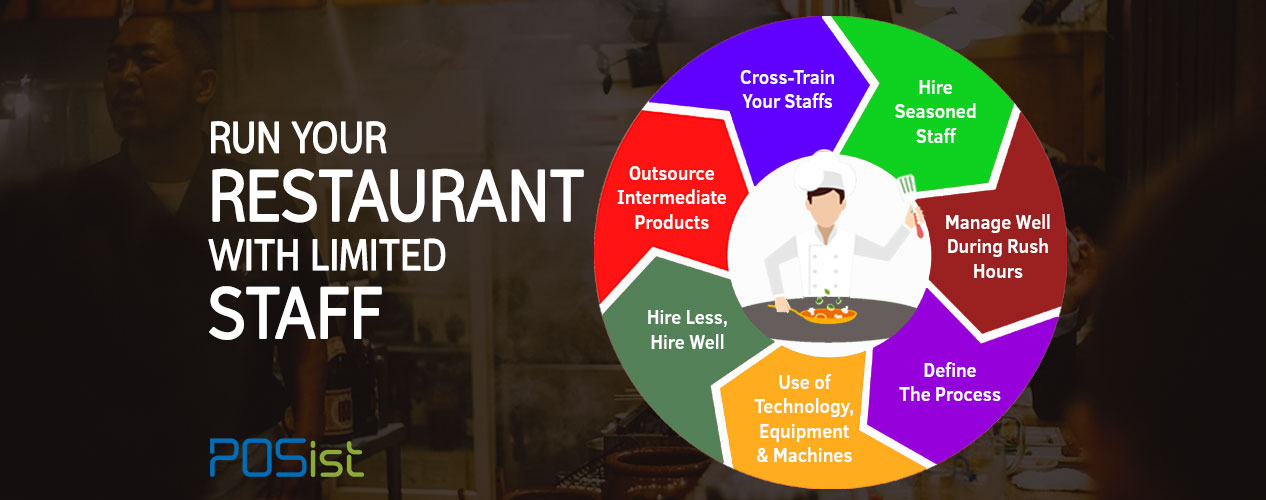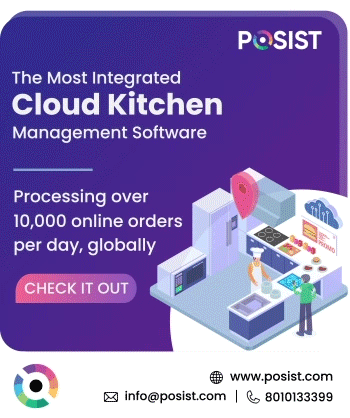One of the most significant costs involved while running a restaurant is the restaurant staff. The percentage of restaurant labor costs to sales average at 22-40%, and in some cases, it can be almost as high as 75%. Especially if you are working on a tight budget, high human resources cost couple with high attrition rate can bleed your restaurant dry. Find out how to reduce the employee turnover in your restaurant here. However, it doesn’t mean you need to spend a bomb right at the beginning of your restaurant venture. In this article, we will tell you how to run a restaurant even with a limited staff, and still, rake profits.
How to Run a Restaurant Even With A Limited Restaurant Staff
Running a restaurant with a limited restaurant staff is an art, which most restaurant owners fail to comprehend. Read below and know further about how to run a restaurant with limited staff.
1. Hire Less, Hire Well
You must be aware that for a fine dining restaurant if in the jest of controlling cost you only hire 10-15 restaurant employee, then you will be compromising on the service, and you will gain a lot of negative reviews. Similarly, if for a small QSR you hire 15 or 20 staff you will be making a blunder as well. Hence, you must know which format would require how many staff. When it comes to fine dining, the average number of staff required will be above 25, for casual dine it should be around 15, for pubs and bars it should be more than 25, for café or bistro you would need 10-15 staffs, for QSR you would need 7 staff, for food truck and food cart you would need around 5 staff, for bakery you would want 10-15 staff, sweet shop would need around 7-10 staff, and an Ice cream parlor would need 7 staff. Not all of them would be permanent staff; these may include part-time and seasoned staff as well.
This clearly shows that while hiring more can be dangerous, hiring less can also be a blunder. Thus, hiring less, but hiring well should be your mantra! This article will tell you how to hire better for your restaurant.
2. Cross-Train Your Staff
Cross-training is an advantageous method that you must implement before you start a restaurant. This will help employees to learn new skills and be ready to take up new roles. Instead of hiring a large number of employees you can go ahead and try taking leverage of your already existing internal staff talents. Cross-training and restaurant management training will enable all your employees to take on any role when other employees are not present for various reasons like injuries, illness, family emergency or some other issues. For example, when the hosting staff is not present, the wait staff or the manager can try taking up the job of welcoming the customers. Similarly, if you have in-house serving staff, they can be asked to take care of other duties like putting the tablecloth, refilling the water during slow hours.
Once in a week, you can arrange for a pre-shift meeting over lunch that will help you to build a relationship with your employees.
Well trained restaurant employees who have a feeling of belongingness will work more efficiently, and there are higher chances that they will stay longer in your restaurant and provide a more consistent level of service to your customers. It is a good idea to specify your restaurant service standards in the form of a ready reckoner that your staff can consult at any time.
3. Manage Your Restaurant Staff Well Especially During Rush Hours
You should allocate work to your staff depending on your sales per hour. As sales fluctuate, it is necessary to maintain the labor cost that will allow you to churn out more profit. Keeping a large staff force during a slow sales period will unexpectedly reduce the quality of their service at peak times. There are many scheduling tools will help you in the scheduling of restaurant employees and will ensure that you distribute your staff as per your business hours; this will keep the performance of your staff at peak. Learn how to manage your restaurant employee shifts effectively here.
You should also remember that rush hours tend to change from season to season. Hence, you need to adjust your plan and schedules of your staffs accordingly. For example, during festivals and holidays, restaurants see a sudden influx of customers.
For such instances, you can hire seasoned employees who will assist the permanent staff and will ease the operations of your restaurant.
5. Use Technology, Equipment, and Machines
Use of technology can reduce your dependency on the manual labor. In addition to this, restaurant management software nowadays has features like server app, stock, and inventory, recipe management, table order will allow your customers to place orders directly through an app, and all such related features will reduce your dependency on the staff force. Proper kitchen equipment and machines are also fundamentally important. You must keep in tune with the new kitchen equipment innovations and bring them into your kitchen that will help you it run your operations and surprise your customers with new menu items. The machines deliver a consistent product, increase speed phenomenally, never ask for leaves, and are there before anyone else arrives at work and after everyone leaves.
Not only will it help you to run your restaurant in a more diligent manner, but you will also be able to save yourself from the unnecessary hassles that happen among the staffs on various occasions.
6. Hire Seasoned or Part-Time Staff
You can hire seasoned staff in times of festive seasons that will help you to cope up with the high rush that you might encounter during this time of the year. Part-time staff can be hired not only during the festive season; they can also be employed on a daily basis during the busy hours of the day as well. Hiring seasoned and part-time staffs will not only enable you to reduce the cost that you incur on labor, but it will also help you to manage the working of your restaurant well. Now various types of staffs are required to run a restaurant. This article will tell you how to create an efficient human resource structure in your restaurant.
(i) Chefs
Tapping the right chef is a primary task that you must give full attention to. There are different types of chefs, and their salaries depend on their experience, location, and training. Thus having too many chefs in the house won’t do you much good. On the contrary, you can have one head chef and one or two sou chefs. In addition to this, you can take the help of a consultant chef who might visit your restaurant once in a while and can suggest special additions to your menu that will bolster your overall profit.
(ii) Managers
They are those who run your restaurant. Hence, instead of hiring too many of them you can hire the one who is competent enough and with whom you have your trust who can run your restaurant without pulling you down into trouble. Managers are the ones who are in touch with all your vendors; he knows all the sources from where your restaurant’s primary products and beverages are purchased, and he must always be the one to open and close the restaurant. This is why it is often seen the managers are overworked; this leads to high turnover rates. To reduce this tendency, make sure to hire seasoned staff that will help the manager during low rush hours so that the performance of the permanent manager is at its peak during the high rush hours. Doing so will help you to run your restaurant with limited staff while it will save a lot of your cost incurred by permanent professionals.
However, it must be mentioned that on several occasion it is seen that, for small budget restaurants, restaurant owners themselves work as the restaurant manager. Here the owners can save a lot of costs that are incurred in hiring. So you must take decisions according to the size and format of your restaurant.
(iii) Cooks
Too many cooks in your kitchen can spoil the broth. Hence, during rush hours you can hire professionals, especially during the festivals. You can also hire chefs who have their specializations in particular cuisines as per the festivals; this will add some interesting items on your menu and will attract the ones who want to taste the specialties of that particular festival. You can hire part-time or seasonal cooks for peak hours such as weekends, who can work as a line cook, while they can make some simple preparation during comparatively slower periods.
(iv) Dishwashers
Dishwashers are needed to keep clean dishes available at your restaurant. You can get not more than two-part-time dishwashers depending on the size of your restaurant and the average number of customers you attend to on a daily basis. Make sure that both the dishwashers attend different shifts, for example; one can work the lunch shift and the other for the dinner shift. If your restaurant is open for three shifts, for instance, for breakfasts as well, then you can either go for one full time and one part-time person or three part-time dishwashers for three different shifts.
(v) Serving Staff
The importance of the serving staff increases during the rush hours of the day. For instance, it is the lunch hour that generally starts from the 11.30 am and continues until 1.30pm -2.30 pm. After this time span, restaurants run typically slowly until 7.00-8.00 pm, after which the dinner crowd starts pouring in. The dinner shift continues until the closing of the restaurant for the day. If you have in-house permanent serving staff during slow periods, you can ask them to take care of other duties, such as refilling containers and taking care of the kitchen.
You can reduce the number of the wait staff in your restaurant after you have survived the initial days of struggle after starting your restaurant. Initially, you must hire professionals, so that you don’t leave a bad impression on your customers who have the potential of being a long-term customer. After the initial days, you can retain the best ones and start an in-house training program where you can train the part-time servers who can serve you during rush hours. So, you must start with less staff and hire more as per the influx of customers.
(vi) Hosting Staffs
You might require some staff that will welcome your guests, take reservations, helps to bring the guests to their designated seats and sometimes work as a cashier depending on the flow of customers. Times when the rush is too high, you can manage by hiring part-time staff and have managers and wait staff to handle these activities during the slow period.
(vii) Bartenders
Depending on the size of your bar you can strategize on the number of bartenders required. Never count on just one bartender, if by chance something happens, and they can’t make it on a specific day, you naturally cannot lose on that night’s business. Keeping two bartenders will be the most intelligent move, one might be a full time while the other part-time who will be there to assist during the peak hours. After keeping track of the influx of customers if you find out that, your bar attracts customers both during the lunch and the dinner hours, then you might need two or three bartenders, or you might try keeping one full-time bartender or bar manager, plus two or three part-time helpers that will assist the permanent ones.
7. Outsourcing Intermediate Products
Trying to make everything from scratch in your restaurant with not only take a lot of time, but it will also incur a lot of expenditure in addition to this you would also need to have a large staff force to carry on with the operations. Hence, outsourcing intermediary products is a great way to carry on with the process.
We hope you found these tips on how to run a restaurant with only a few hands useful. Remember these tips the next time a waiter takes an unexpected leave during the peak season!



















